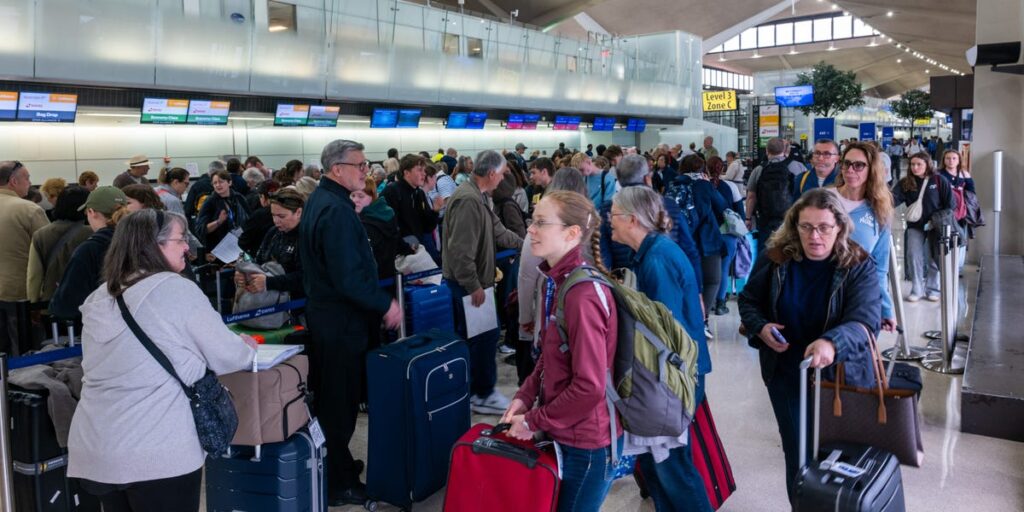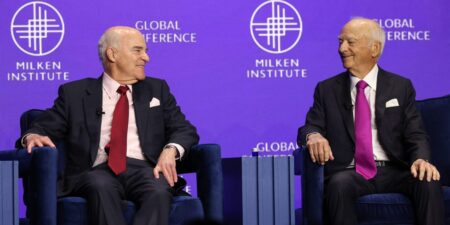A week of compounding crises at New Jersey’s Newark Liberty International Airport has some travelers questioning if they should change their travel plans to avoid the airport altogether.
Travel chaos has been ongoing at Newark since April 28, when air traffic issues first forced dozens of delays and more than 100 cancellations.
Since then, thousands more flights have been disrupted, leaving plane loads of passengers stranded at one of the busiest US airports.
This has ultimately forced United, the airport’s biggest airline, to pull 35 daily flights, or about 10% of its Newark schedule, until further notice.
The airport has long dealt with delays caused by a shortage of air traffic control staff. But now, its main runway is closed for construction until at least June, and classic April rain showers have only made things worse.
Atmosphere Research Group travel analyst Henry Hardevelt told Business Insider that those stuck in chaos should keep their wits, and those traveling in the near future may want to consider the New York City area’s other airports or another United hub.
Avoid Newark or brace for inevitable disruptions
New York’s John F. Kennedy International Airport and LaGuardia Airport are the most obvious alternatives to Newark, but Hardevelt said there’s also Long Island MacArthur Airport and Westchester Airport in White Plains.
These suburban options are further from the city, and they won’t have the same plethora of flight connections. The same goes for LaGuardia, which has a perimeter rule that only allows flights longer than 1,500 miles, like United’s flight to Denver, on Saturdays.
NerdWallet travel analyst Sally French told BI to allow plenty of extra time for your connection if Newark is your only option. She added that customers should avoid checking a bag as carry-on only allows for more flexibility to switch flights or airports.
If you want to stick with United but still avoid Newark as a layover, you could travel via United’s hubs in Houston, Washington, DC, Denver, and Chicago instead. You could also use these hubs as a connection to LaGuardia if you still need to get to the New York City area, but without the added risk of flying to Newark.
The airline says fees and fare differences are waived for flight changes from May 6 to May 17 for tickets purchased before May 4, so long as the origin and destination cities remain the same, or one of LaGuardia or Philadelphia.
If you need a long-haul international connection, however, Newark may be your only choice, as United doesn’t fly to New York-JFK.
Some loyalty customers may prefer to deal with Newark, and Hardevelt said customers should ask to be booked on one of United’s partner airlines if their original flight is disrupted.
“If Newark is your only option, gird your loins and pack your patience,” Hardevelt said, adding that customers should not vent their frustrations at the airline’s employees.
How things got so bad at Newark
It’s not uncommon for major airports to experience days of disruptions due to weather and equipment, like the January winter storms or the CrowdStrike fiasco in 2024. When a combination of factors coexist, things can get extra chaotic.
In July 2024, the Federal Aviation Administration moved the ATC arrivals operation that handles Newark from New York to Philadelphia to address staffing issues, though the same problem has appeared regardless of where the traffic flows. Equipment failures at the facility have only added to the backups.
The closure of the airport’s busiest runway is expected to last until at least June as planes wait to use alternates.
United CEO Scott Kirby said in a letter to customers on Friday that the compounding problems were exacerbated by 20% of controllers “walking off the job.” He added that the facility has been “chronically understaffed for years.” It’s unlikely things will change anytime soon until capacity is under control.
Kirby urged the government to reclassify Newark as a “Level 3” airport, meaning it would use a slot system to manage capacity by limiting the number of planes that can take off and land at certain times. Both New York-JFK and LaGuardia are slot-controlled.
The Port Authority of New York and New Jersey also blamed the FAA for the chaos, telling BI it has invested billions of dollars to modernize Newark but that those improvements rely on a “fully-staffed and modern federal air traffic system.”
“We continue to urge the FAA to address ongoing staffing shortages and accelerate long-overdue technology upgrades that continue to cause delays in the nation’s busiest air corridor,” a spokesperson said.
As of Monday afternoon, no delays at Newark were due to staffing or ATC, though rain in the area had incoming flights delayed by an average of more than three hours.
The federal government has long tried to get a grip on air traffic control staffing. The FAA said in May 2024 that it was about 3,000 controllers short.
The Trump Administration in February announced an effort to “supercharge” ATC hiring. This includes upping trainee pay, offering up to $15,000 in incentives to new hires, reducing the hiring process by five months, and providing new opportunities to veteran controllers.
Read the full article here
















